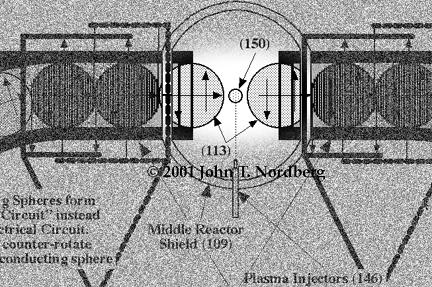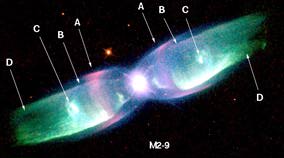
The Ball-of-Light Particle Model predicts the core of a normal star is a decaying balls-of-light surrounded by a plasma envelope. In our star, the sun, the core is a single elementary particle approximately 1/3 the size of the visible sun. (A quick proof of this is my solar activity predictions match actual solar activity.)
Normally, the core of a star has one primary electromagnetic and gravitational wave that sweeps from pole to pole. Below is a QuickTime animation of a spherical electromagnetic wave. For simplicity, the gravitational field is not shown.
Note how the wave sweeps back and forth from pole to pole. The gravitational field points towards the center of the sphere. In a stable star, this wave is relatively weak. However, in some cases, this wave can suddenly become powerful. Two examples of the cause of this wave being strengthened include: an impact from a planet; and a death spiral of a planet.
Below is an animated gif demonstrating a stellar impact. A comet, meteorite, or planet collides with the star. The collision creates a massive wave that sweeps across the enveloping plasma. The moving plasma wave induces waves on the core -- depicted by a solid black line. The wave on the core induces and ejects balls-of-light off the right pole, then rebounds and ejects more balls-of-light off the left pole.
The sweeping electromagnetic and gravitational wave, if powerful enough, can eject material off the poles of the star. These globs of plasma, and smaller decaying balls of light, are called ansae. A good example is this Hubble image of NGC 7009.
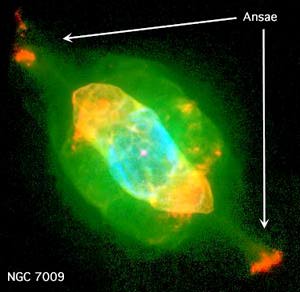
Traditional theory does not have such an easy time explaining ansae. Other good examples of ansae are the Hubble images below of NGC 3242 and NGC 6826.
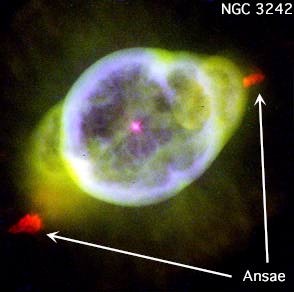
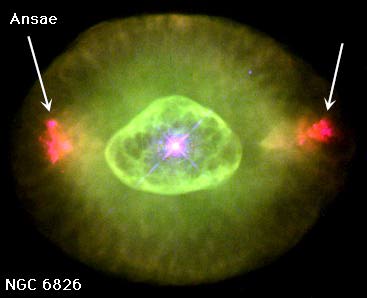
Could this happen to our sun. Yes. At any time! There are at least 3 known comets imaged by the SOHO satellite that have done this on a small scale -- and I sure the must have been some larger scale occurrences in the past.
The press releases that came out with these movies said that the coronal mass ejections that happened after the comets hit were just coincidences. I do not believe they were.
(See also, Induction off the Sun's Core) (See also, Sunspots, and Blinkers) (See also, a comet hitting and an orbiting star.)
When the electromagnetic waves reach the poles, they induce balls-of-light. These balls-of-light are ejected from the core at high speed due to electromagnetic repulsion. The following animated GIF demonstrates how electric fields (magenta) and magnetic fields (blue) might sweep across a ball-of-light and induce another ball-of-light off the pole.
The additional possibility that the ejected balls-of-light might decay by splitting into smaller balls-of-light.
In some cases, the event will completely blow the surrounding plasma envelope completely off. This reveals the solar core which is inappropriately called a white dwarf. Such white dwarfs typically have a nonthermal radiation signature and are typically described as being, "one of the hottest known objects." The radiation is nonthermal not because electrons are spiraling in a magnetic field as typically described, but because the radiation is induced by the powerful electromagnetic fields directly on the core.
An example of an artificial plasma pinch made in the laboratory is:
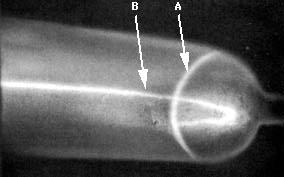
There is a magnetic field that curls around the tubular portion of the plasma. Then, at A, the field reverses, pinching the plasma. If this example is duplicated and flipped 180 degrees, it would look like the next example:
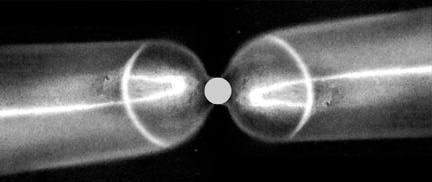
While the example is not perfect, note the similarity to the real planetary nebula M2-9:

And to Eta Carinae:
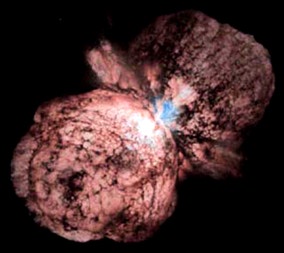
My new fusion reactor designs -- patent pending -- utilize this geometrical configuration.
